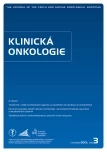Management of Breakthrough Cancer Pain
Authors:
O. Sláma
Authors‘ workplace:
Ambulance podpůrné a paliativní onkologie, Klinika komplexní onkologické péče, Masarykův onkologický ústav, Brno
Published in:
Klin Onkol 2013; 26(3): 191-194
Category:
Review
Overview
Breakthrough cancer pain has been defined as a transitory increase in pain intensity that occurs despite relatively stable and adequately controlled background pain. More than half of cancer patients with chronic pain suffer by some form of breakthrough cancer pain. The management of breakthrough cancer pain is comprehensive and includes pharmacological and non‑pharmacological approaches. The principal treatment strategies are optimization of regular analgesic medication combined with effective rescues medication. The new transmucosal forms of fentanyl represent an important improvement in our treatment options.
Key words:
breakthrough pain – fentanyl – opioids – optimization of analgesic medication – rescue medication
Sources
1. Hanks GW, Conno F, Cherny N et al. Morphine and alternative opioids in cancer pain: the EAPC recommendations. Br J Cancer 2001; 84(5): 587– 593.
2. Portenoy RK, Forbes K, Lussier D et al. Difficult pain problems: an integrated approach. In: Doyle D, Hanks G, Cherny N (eds). Oxford textbook of palliative medicine. 3rd ed. Oxford: Oxford University Press 2003: 438– 458.
3. Sláma O, Lejčko J, Kozák J et al. Epidemiologie a léčba průlomové bolesti u onkologických pacientů v ČR. Výsledky výzkumného projektu PARMA. Část 1. Prevalence a klinické charakteristiky průlomové bolesti. Bolest 2011; 14(1): 158– 160.
4. Mercadante S. Breakthrough pain: on the road again. Eur J Pain 2009; 13(4): 329– 330.
5. Kabelka L, Lejčko J, Kozák J et al. Doporučený postup pro léčbu průlomové nádorové bolesti. Farmakoterapie 2011; 7(5): 521– 523.
6. Wu JS, Monk G, Clark T et al. Palliative radiotherapy improves pain and reduces functional interference in patients with painful bone metastases: a quality assurance study. Clin Oncol 2006; 18(7): 539– 544.
7. Ripamonti C, Fagnoni E, Campa T et al. Incident pain and analgesic consumption decrease after samarium infusion: a pilot study. Support Care Cancer 2007;15(3): 339– 342.
8. Ripamonti C, Fagnoni E, Campa T et al. Decreases in pain at rest and movement‑related pain during zoledronic acid treatment in patients with bone metastases due to breast or prostate cancer: a pilot study. Support Care Cancer 2007; 15(10): 1177– 1184.
9. Burton AW, Reddy SK, Shah HN et al. Percutaneous vertebroplasty: a technique to treat refractory spinal pain in the setting of advanced metastatic cancor: a case series. J Pain Symptom Manage 2005; 30(1): 87– 95.
10. Mercadante S, Villari P, Ferrera P et al. Optimization of opioid therapy for preventing incident pain associated with bone metastases. J Pain Symptom Manage 2004; 28(5): 505– 510.
11. Zeppetella G, Ribeiro MD. Opioids for the management of breakthrough (episodic) pain in cancer patients. Cochrane Database Syst Rev 2006; (1): CD004311.
12. Coluzzi PH, Schwartzberg L, Conroy JD et al. Breakthrough cancer pain: a randomized trial comparing oral transmucosal fentanyl citrate (OTFC) and morphine sulfate immediate release (MSIR). Pain 2001; 91(1– 2): 123– 130.
13. Blick SK, Wagstaff AJ. Fentanyl buccal tablet: in breakthrough pain in opioid‑ tolerant patients with cancer. Drugs 2006; 66(18): 2387– 2395.
14. Lennernäs B, Hedner T, Holmberg M et al. Pharmacokinetics and tolerability of different doses of fentanyl following sublingual administration of a rapidly dissolving tablet to cancer patients: a new approach to treatment of incident pain. Br J Clin Pharmacol 2005; 59(2): 249– 253.
15. Kress HG, Orońska A, Kaczmarek Z et al. Efficacy and tolerability of intranasal fentanyl spray 50 to 200 µg for breakthrough pain in patients with cancer: a phase III multinational, randomised, double blind, placebo‑ controled, crossover trial with a 10- month, open label extension treatment period. Clin Ther 2009; 31(6): 1177– 1191.
Labels
Paediatric clinical oncology Surgery Clinical oncologyArticle was published in
Clinical Oncology

2013 Issue 3
- Metamizole vs. Tramadol in Postoperative Analgesia
- Metamizole at a Glance and in Practice – Effective Non-Opioid Analgesic for All Ages
- Possibilities of Using Metamizole in the Treatment of Acute Primary Headaches
- Current Insights into the Antispasmodic and Analgesic Effects of Metamizole on the Gastrointestinal Tract
- Spasmolytic Effect of Metamizole
Most read in this issue
- Prostate Carcinoma. Current Dilemma of Urooncology. How to Help the Needed and not to Harm the Others
- Results of Curative Chemoradiotherapy in Patients with Carcinomas of the Anus
- Communication as a Part of the Supportive Treatment in Cancer Care
- Lenalidomide Maintenance Therapy in Patients with Multiple Myeloma
